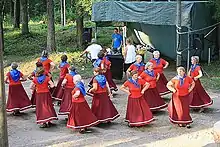Võros
Võros (Võro: võrokõsõq, pronounced [vɤrokɤsəʔ], Estonian: võrukesed, Finnish: võrolaiset) are inhabitants of historical Võromaa (Vana Võromaa), a region in Southeastern Estonia (Võru and Põlva Counties with parts extending into Valga and Tartu Counties). The term is particularly used by proponents of a regional identity.
 Võro flag | |
 Traditional dance of Võros | |
| Total population | |
|---|---|
| 50,000 to 70,000 (74,499[1]) (about 4–7% of the population) | |
| Regions with significant populations | |
| Languages | |
| Võro, Standard Estonian | |
| Religion | |
| Eastern Orthodox, Evangelical Lutheran | |
| Related ethnic groups | |
| Estonians · Setos |
About 70,000 people live in historical Võromaa and many more identify as Võros although they live outside the territory, mostly in Tartu and Tallinn.
See also
- Võru County (Võrumaa, Võromaa)
- Võro language
- Võro Institute
- Võro language newspaper Uma Leht
External links
References
- "Eesti Emakeelega Püsielanikud Murdekeele Oskuse Ja Soo Järgi, 31. Detsember 2011" (in Estonian). Statistikaamet, Pub.stat.ee. Retrieved 2014-08-23.
- Ehala, Martin & Niglas, Katrin (2007): Empirical evaluation of a mathematical model of ethnolinguistic vitality: the case of Võro. Journal of Multilingual and Multicultural Development.
- Eichenbaum, K.; Pajusalu, K. (2001): Setode ja võrokeste keelehoiakutest ja identiteedist. - Keel ja Kirjandus nr 7, lk. 483-489.
- Eller, K. (1999): Võro-Seto language. Võro Instituut'. Võro.
- Valk, A. (2000). Võrokeste identiteedist. K. Koreinik, J. Rahman (toim.) A kiilt rahvas kynõlõs.. Võrokeste keelest, kommetest, identiteedist (lk. 39-56). Võro Instituut, Võro.
This article is issued from Wikipedia. The text is licensed under Creative Commons - Attribution - Sharealike. Additional terms may apply for the media files.